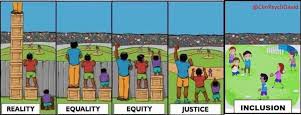Abstract
Excerpted From: Deja R. Graham, Inequity: Hurdles for the Marginalized, 19 Southern Journal of Policy and Justice 172 (May, 2025) (270 Footnotes) (Full Document Requested)
 At the formation of our country a hierarchy of race was known, prevalent and adhered to. This hierarchy was demonstrated not only through slavery but through the drafting of the constitution, its amendments, and subsequent laws. The three-fifths clause of the constitution made it clear that the famous words that united us post British colonialism, “We the people”, really meant we the white people. The nation's founding document and its amendments were drafted with the pen of racism and white supremacy. The United States' history of racism and the system of white supremacy that it established cannot be erased through willful blindness to its existence.
At the formation of our country a hierarchy of race was known, prevalent and adhered to. This hierarchy was demonstrated not only through slavery but through the drafting of the constitution, its amendments, and subsequent laws. The three-fifths clause of the constitution made it clear that the famous words that united us post British colonialism, “We the people”, really meant we the white people. The nation's founding document and its amendments were drafted with the pen of racism and white supremacy. The United States' history of racism and the system of white supremacy that it established cannot be erased through willful blindness to its existence.
The Supreme Courts jurisprudence in the realm of policing, voting, and affirmative action policies demonstrates the naive belief that racism and white supremacy is an issue of the past. The Courts race- neutral approach in these realms hinders us from creating a just society for all Americans. The current jurisprudence in these realms upholds the system of white supremacy by pushing Black people closer to the margin leaving them to begin the race behind the starting line. This is proven through the Courts broad interpretation of police power under the Fourth Amendment and its disparate impact on Black Americans. This is demonstrated in voting and affirmative action policies, with these laws and policies now being deemed unnecessary, though Black people still fall victim to voter suppression and have significantly lower educational attainment.
This argument can be illustrated using a sports analogy, in this instance, Track and Field. During slavery, Black people in America were not allowed on the track to participate in the race called, life. Once allowed on the track, with the implementation of the Thirteenth Amendment, Jim Crow laws ensured that it was not the same track as White Americans. While Jim Crow laws were enforced, various hurdles, like voting restrictions and redlining, were placed on the track that Black Americans were using.
In the mid twentieth century, the White and Black tracks merged into one singular track with two caveats: one, the hurdles from the track Black Americans used remained and two, those hurdles were only placed in the lanes in which Black Americans were racing. This is the current state of America, Black Americans are left to play catch up on the race if, and only if, they can overcome these hurdles. The recent jurisprudence regarding voting, policing, and affirmative action has made these hurdles virtually insurmountable. Black people in America and other members of the global majority, who already sit on the outskirts of the margin, are being further marginalized and denied access to fully participation in our society.
[. . .]
Prior to the inception of our country, Black people have and continue to operate on the margins of our society. Generation after generation fighting for a better life for the one that followed. In the race of life, Black people in America have faced a steep uphill journey filled with hurdles to actively participate. The courts race-neutral approach effectively guarantees that Black Americans will continue to sit on the margins. That is, if and only if, they can overcome these hurdles that have now been cemented into their lane by the Supreme Court in the realms of policing, voting, and education.


